power steering SMART FORTWO COUPE ELECTRIC DRIVE 2014 Owners Manual
[x] Cancel search | Manufacturer: SMART, Model Year: 2014, Model line: FORTWO COUPE ELECTRIC DRIVE, Model: SMART FORTWO COUPE ELECTRIC DRIVE 2014Pages: 222, PDF Size: 16.17 MB
Page 8 of 222
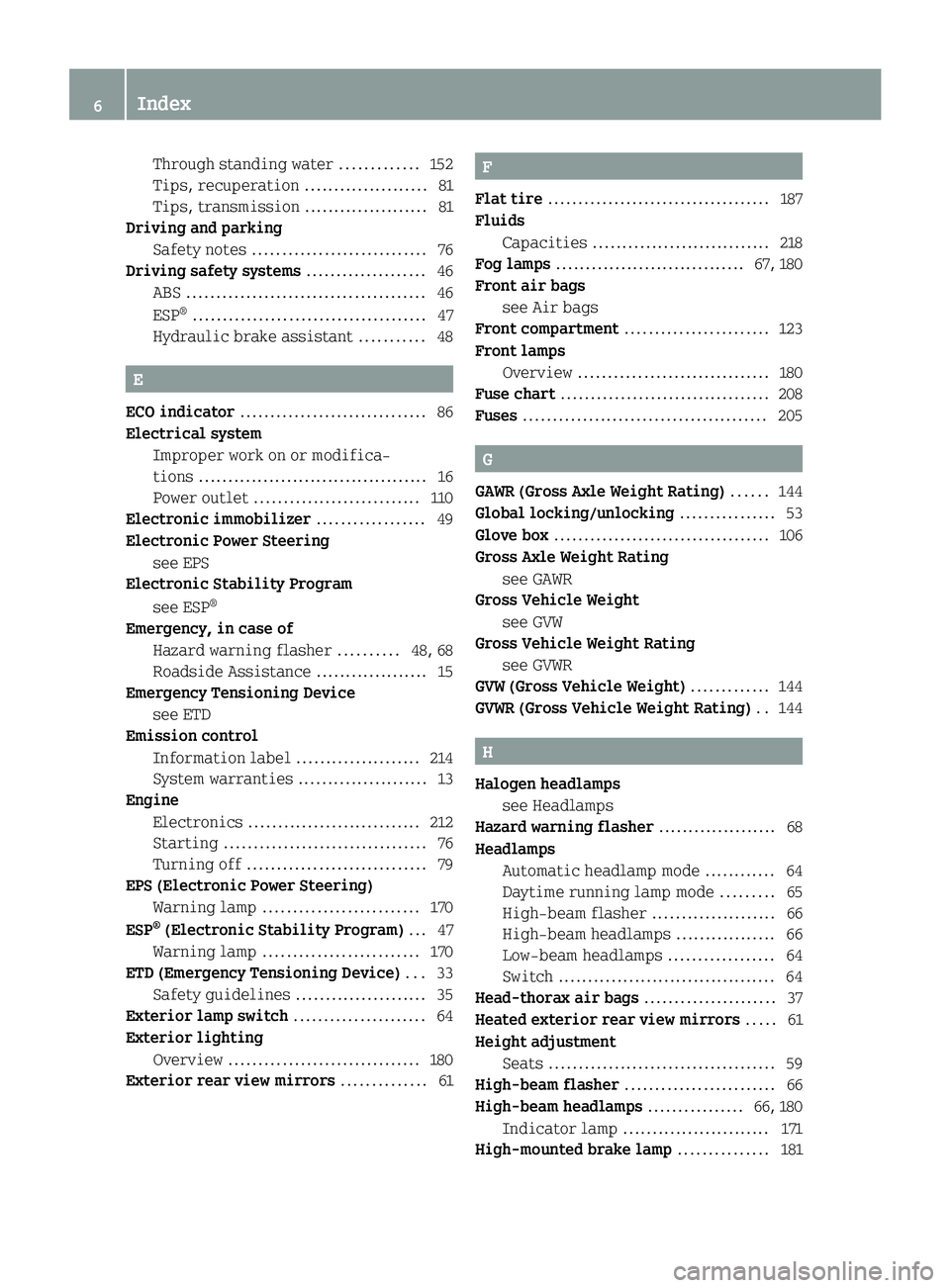
Through standing water
.............152
Tips, recuperation .....................81
Tips, transmission ..................... 81
Driving and parking
Safety notes ............................. 76
Driving safety systems ....................46
ABS ........................................ 46
ESP ®
....................................... 47
Hydraulic brake assistant ...........48 E
ECO indicator ............................... 86
Electrical system Improper work on or modifica-
tions ....................................... 16
Power outlet ............................ 110
Electronic immobilizer ..................49
Electronic Power Steering see EPS
Electronic Stability Program
see ESP ®
Emergency, in case of Hazard warning flasher ..........48, 68
Roadside Assistance ................... 15
Emergency Tensioning Device
see ETD
Emission control
Information label .....................214
System warranties ......................13
Engine
Electronics ............................. 212
Starting .................................. 76
Turning off .............................. 79
EPS (Electronic Power Steering)
Warning lamp .......................... 170
ESP ®
(Electronic Stability Program) ...47
Warning lamp .......................... 170
ETD (Emergency Tensioning Device) ...33
Safety guidelines ......................35
Exterior lamp switch ......................64
Exterior lighting Overview ................................ 180
Exterior rear view mirrors ..............61 F
Flat tire ..................................... 187
Fluids Capacities .............................. 218
Fog lamps ................................ 67, 180
Front air bags see Air bags
Front compartment ........................ 123
Front lamps Overview ................................ 180
Fuse chart ................................... 208
Fuses ......................................... 205 G
GAWR (Gross Axle Weight Rating) ......144
Global locking/unlocking ................53
Glove box .................................... 106
Gross Axle Weight Rating see GAWR
Gross Vehicle Weight
see GVW
Gross Vehicle Weight Rating
see GVWR
GVW (Gross Vehicle Weight) .............144
GVWR (Gross Vehicle Weight Rating) ..144 H
Halogen headlamps see Headlamps
Hazard warning flasher .................... 68
Headlamps Automatic headlamp mode ............ 64
Daytime running lamp mode .........65
High-beam flasher .....................66
High-beam headlamps ................. 66
Low-beam headlamps ..................64
Switch ..................................... 64
Head-thorax air bags ......................37
Heated exterior rear view mirrors .....61
Height adjustment Seats ...................................... 59
High-beam flasher ......................... 66
High-beam headlamps ................66, 180
Indicator lamp ......................... 171
High-mounted brake lamp ...............1816
Index
Page 24 of 222
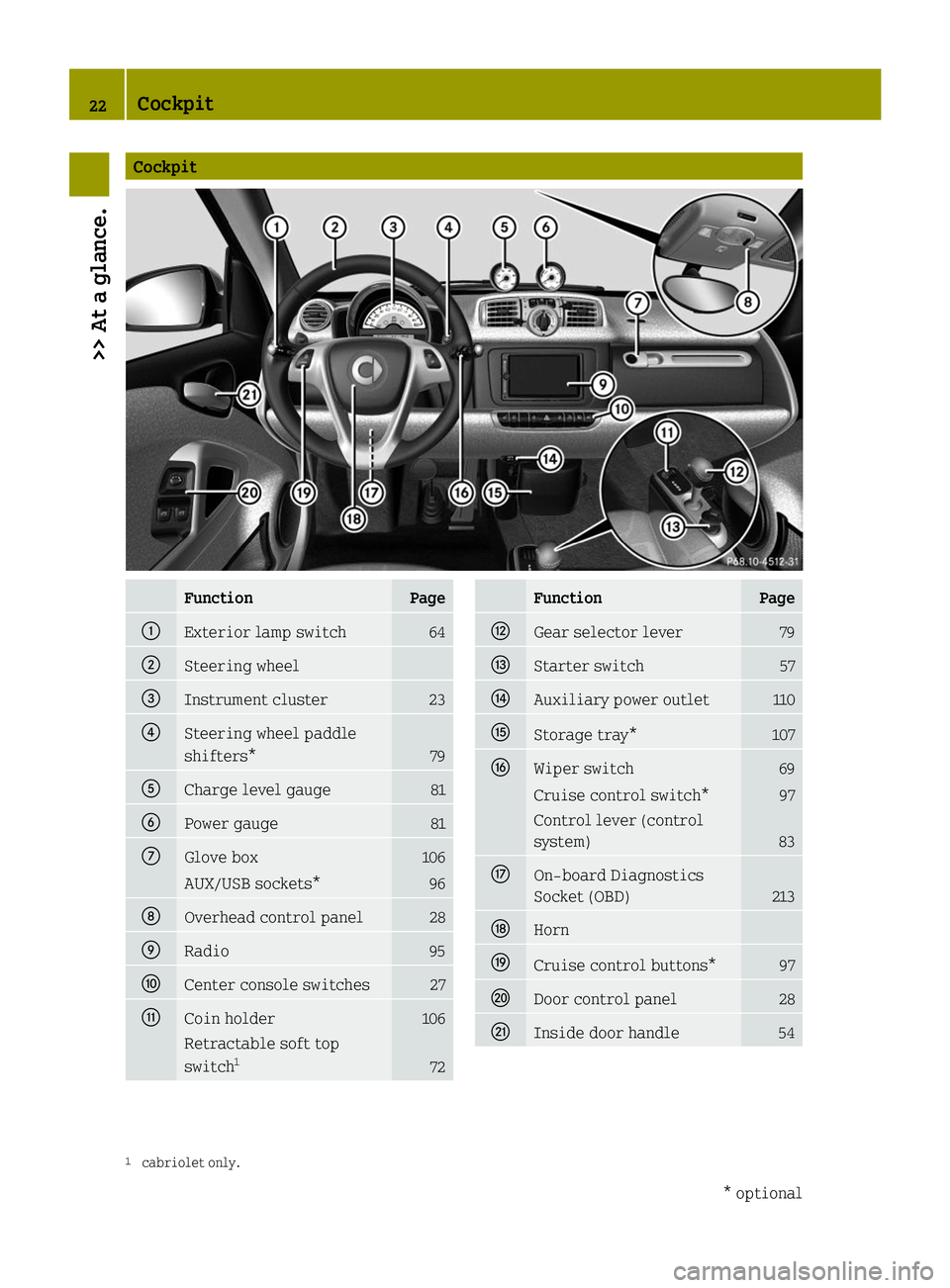
Cockpit
Function Page
0043
Exterior lamp switch 64
0044
Steering wheel
0087
Instrument cluster 23
0085
Steering wheel paddle
shifters*
79
0083
Charge level gauge 81
0084
Power gauge 81
006B
Glove box 106
AUX/USB sockets* 96
006C
Overhead control panel 28
006D
Radio 95
006E
Center console switches 27
006F
Coin holder 106
Retractable soft top
switch 1 72 Function Page
0070
Gear selector lever 79
0071
Starter switch 57
0072
Auxiliary power outlet 110
0073
Storage tray* 107
0074
Wiper switch 69
Cruise control switch* 97
Control lever (control
system)
83
0075
On-board Diagnostics
Socket (OBD)
213
0076
Horn
0077
Cruise control buttons* 97
0078
Door control panel 28
0079
Inside door handle 54
1
cabriolet only. 22
Cockpit>> At a glance.
* optional
Page 49 of 222
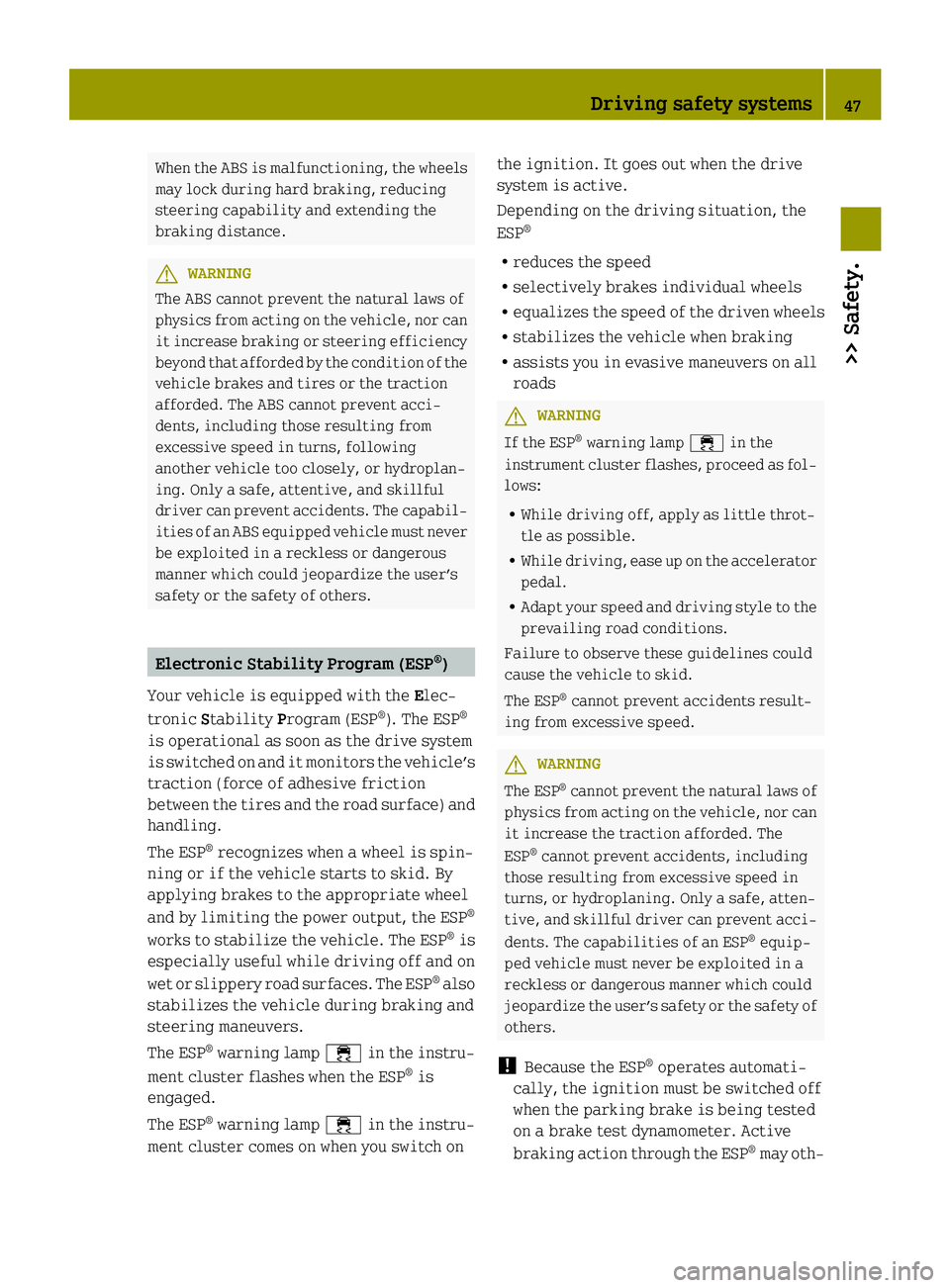
When the ABS is malfunctioning, the wheels
may lock during hard braking, reducing
steering capability and extending the
braking distance. G
WARNING
The ABS cannot prevent the natural laws of
physics from acting on the vehicle, nor can
it increase braking or steering efficiency
beyond that afforded by the condition of the
vehicle brakes and tires or the traction
afforded. The ABS cannot prevent acci-
dents, including those resulting from
excessive speed in turns, following
another vehicle too closely, or hydroplan-
ing. Only a safe, attentive, and skillful
driver can prevent accidents. The capabil-
ities of an ABS equipped vehicle must never
be exploited in a reckless or dangerous
manner which could jeopardize the user’s
safety or the safety of others. Electronic Stability Program (ESP
®
)
Your vehicle is equipped with the Elec-
tronic Stability Program (ESP ®
). The ESP ®
is operational as soon as the drive system
is switched on and it monitors the vehicle’s
traction (force of adhesive friction
between the tires and the road surface) and
handling.
The ESP ®
recognizes when a wheel is spin-
ning or if the vehicle starts to skid. By
applying brakes to the appropriate wheel
and by limiting the power output, the ESP ®
works to stabilize the vehicle. The ESP ®
is
especially useful while driving off and on
wet or slippery road surfaces. The ESP ®
also
stabilizes the vehicle during braking and
steering maneuvers.
The ESP ®
warning lamp 00E5in the instru-
ment cluster flashes when the ESP ®
is
engaged.
The ESP ®
warning lamp 00E5in the instru-
ment cluster comes on when you switch on the ignition. It goes out when the drive
system is active.
Depending on the driving situation, the
ESP ®
R reduces the speed
R selectively brakes individual wheels
R equalizes the speed of the driven wheels
R stabilizes the vehicle when braking
R assists you in evasive maneuvers on all
roads G
WARNING
If the ESP ®
warning lamp 00E5in the
instrument cluster flashes, proceed as fol-
lows:
R While driving off, apply as little throt-
tle as possible.
R While driving, ease up on the accelerator
pedal.
R Adapt your speed and driving style to the
prevailing road conditions.
Failure to observe these guidelines could
cause the vehicle to skid.
The ESP ®
cannot prevent accidents result-
ing from excessive speed. G
WARNING
The ESP ®
cannot prevent the natural laws of
physics from acting on the vehicle, nor can
it increase the traction afforded. The
ESP ®
cannot prevent accidents, including
those resulting from excessive speed in
turns, or hydroplaning. Only a safe, atten-
tive, and skillful driver can prevent acci-
dents. The capabilities of an ESP ®
equip-
ped vehicle must never be exploited in a
reckless or dangerous manner which could
jeopardize the user’s safety or the safety of
others.
! Because the ESP ®
operates automati-
cally, the ignition must be switched off
when the parking brake is being tested
on a brake test dynamometer. Active
braking action through the ESP ®
may oth- Driving safety systems
47>> Safety. Z
Page 79 of 222
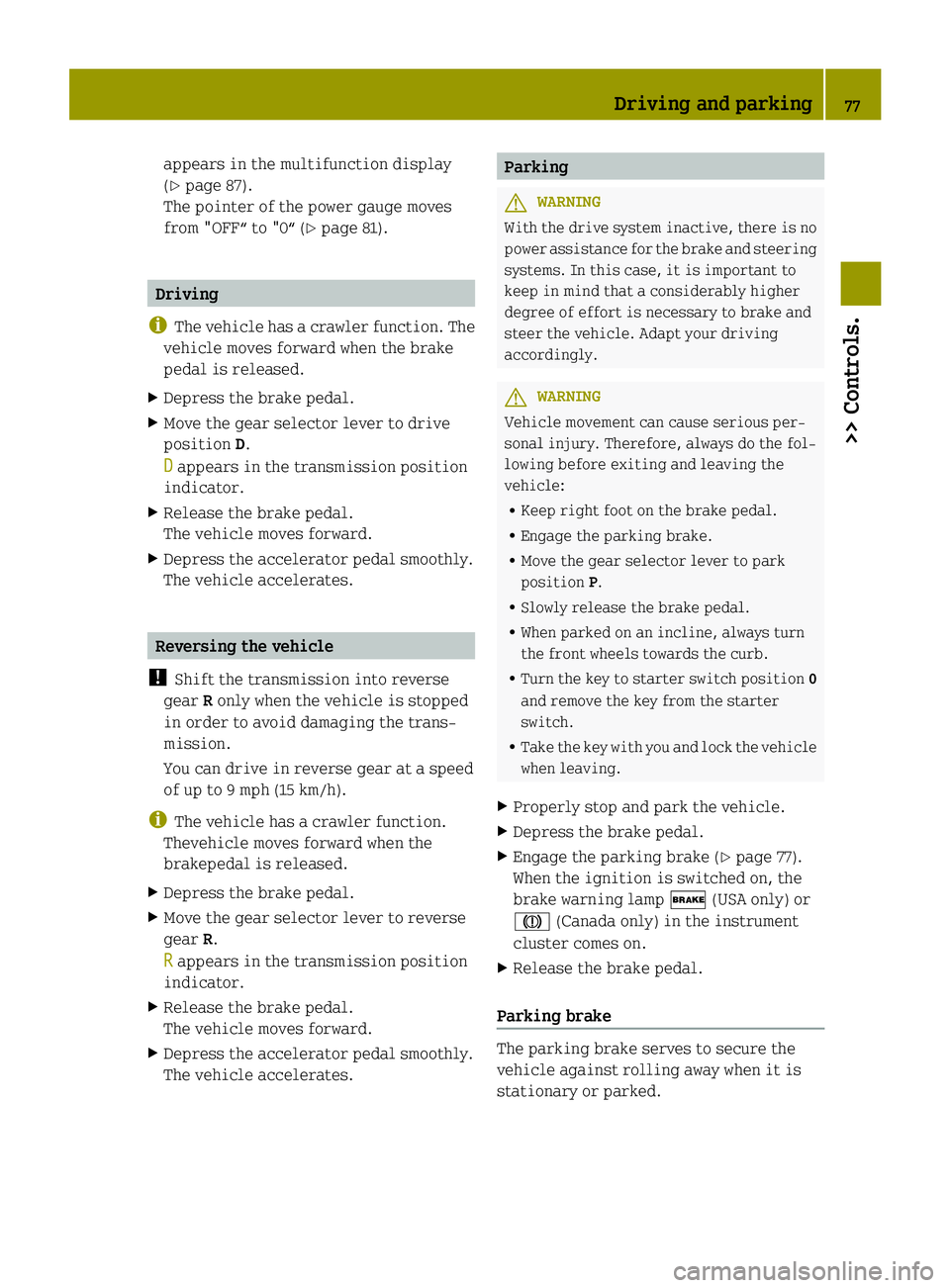
appears in the multifunction display
(Y
page 87).
The pointer of the power gauge moves
from "OFF“ to "0“ (Y page 81).Driving
i The vehicle has a crawler function. The
vehicle moves forward when the brake
pedal is released.
X Depress the brake pedal.
X Move the gear selector lever to drive
position D.
D D appears in the transmission position
indicator.
X Release the brake pedal.
The vehicle moves forward.
X Depress the accelerator pedal smoothly.
The vehicle accelerates. Reversing the vehicle
! Shift the transmission into reverse
gear Ronly when the vehicle is stopped
in order to avoid damaging the trans-
mission.
You can drive in reverse gear at a speed
of up to 9 mph (15 km/h).
i The vehicle has a crawler function.
Thevehicle moves forward when the
brakepedal is released.
X Depress the brake pedal.
X Move the gear selector lever to reverse
gear R.
R R appears in the transmission position
indicator.
X Release the brake pedal.
The vehicle moves forward.
X Depress the accelerator pedal smoothly.
The vehicle accelerates. Parking
G
WARNING
With the drive system inactive, there is no
power assistance for the brake and steering
systems. In this case, it is important to
keep in mind that a considerably higher
degree of effort is necessary to brake and
steer the vehicle. Adapt your driving
accordingly. G
WARNING
Vehicle movement can cause serious per-
sonal injury. Therefore, always do the fol-
lowing before exiting and leaving the
vehicle:
R Keep right foot on the brake pedal.
R Engage the parking brake.
R Move the gear selector lever to park
position P.
R Slowly release the brake pedal.
R When parked on an incline, always turn
the front wheels towards the curb.
R Turn the key to starter switch position 0
and remove the key from the starter
switch.
R Take the key with you and lock the vehicle
when leaving.
X Properly stop and park the vehicle.
X Depress the brake pedal.
X Engage the parking brake (Y page 77).
When the ignition is switched on, the
brake warning lamp 0027(USA only) or
004D (Canada only) in the instrument
cluster comes on.
X Release the brake pedal.
Parking brake The parking brake serves to secure the
vehicle against rolling away when it is
stationary or parked. Driving and parking
77>> Controls. Z
Page 81 of 222
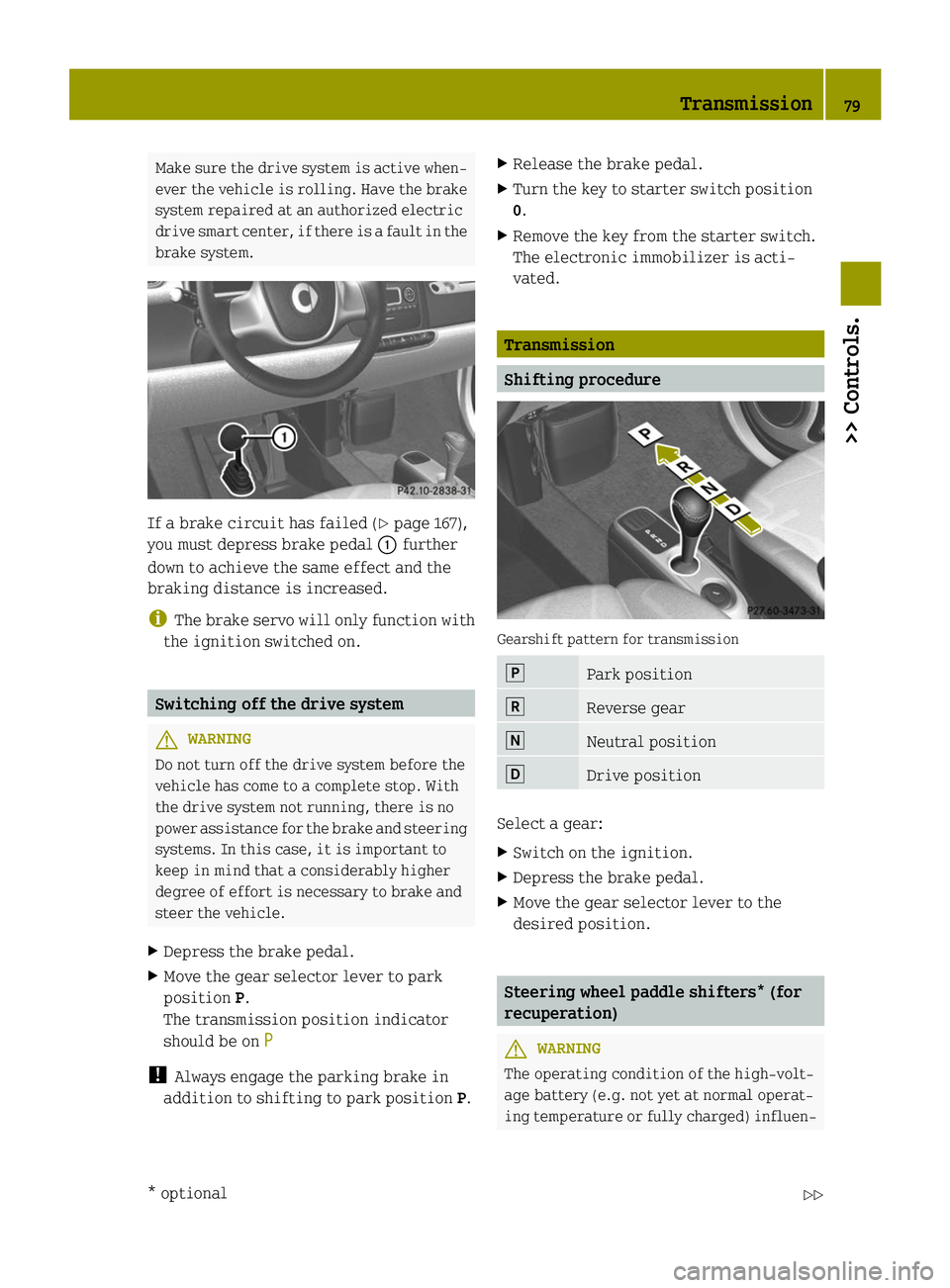
Make sure the drive system is active when-
ever the vehicle is rolling. Have the brake
system repaired at an authorized electric
drive smart center, if there is a fault in the
brake system. If a brake circuit has failed (Y
page 167),
you must depress brake pedal 0043further
down to achieve the same effect and the
braking distance is increased.
i The brake servo will only function with
the ignition switched on. Switching off the drive system
G
WARNING
Do not turn off the drive system before the
vehicle has come to a complete stop. With
the drive system not running, there is no
power assistance for the brake and steering
systems. In this case, it is important to
keep in mind that a considerably higher
degree of effort is necessary to brake and
steer the vehicle.
X Depress the brake pedal.
X Move the gear selector lever to park
position P.
The transmission position indicator
should be on P P
! Always engage the parking brake in
addition to shifting to park position P.X
Release the brake pedal.
X Turn the key to starter switch position
0.
X Remove the key from the starter switch.
The electronic immobilizer is acti-
vated. Transmission
Shifting procedure
Gearshift pattern for transmission
005D
Park position
005E
Reverse gear
005C
Neutral position
005B
Drive position
Select a gear:
X
Switch on the ignition.
X Depress the brake pedal.
X Move the gear selector lever to the
desired position. Steering wheel paddle shifters* (for
recuperation)
G
WARNING
The operating condition of the high-volt-
age battery (e.g. not yet at normal operat-
ing temperature or fully charged) influen- Transmission
79>> Controls.
* optional Z
Page 82 of 222
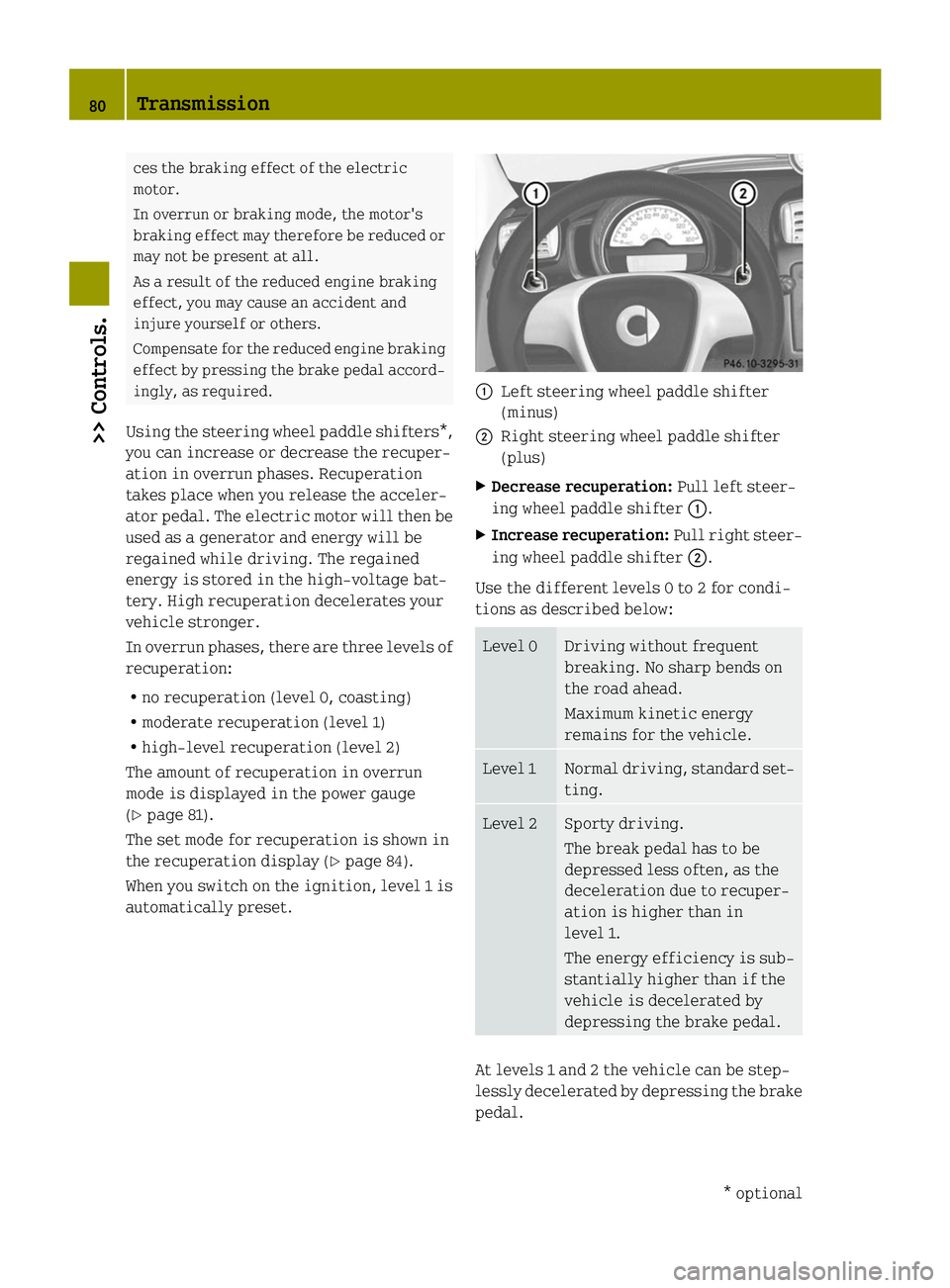
ces the braking effect of the electric
motor.
In overrun or braking mode, the motor's
braking effect may therefore be reduced or
may not be present at all.
As a result of the reduced engine braking
effect, you may cause an accident and
injure yourself or others.
Compensate for the reduced engine braking
effect by pressing the brake pedal accord-
ingly, as required.
Using the steering wheel paddle shifters *,
you can increase or decrease the recuper-
ation in overrun phases. Recuperation
takes place when you release the acceler-
ator pedal. The electric motor will then be
used as a generator and energy will be
regained while driving. The regained
energy is stored in the high-voltage bat-
tery. High recuperation decelerates your
vehicle stronger.
In overrun phases, there are three levels of
recuperation:
R no recuperation (level 0, coasting)
R moderate recuperation (level 1)
R high-level recuperation (level 2)
The amount of recuperation in overrun
mode is displayed in the power gauge
(Y page 81).
The set mode for recuperation is shown in
the recuperation display (Y page 84).
When you switch on the ignition, level 1 is
automatically preset. 0043
Left steering wheel paddle shifter
(minus)
0044 Right steering wheel paddle shifter
(plus)
X Decrease recuperation: Pull left steer-
ing wheel paddle shifter 0043.
X Increase recuperation: Pull right steer-
ing wheel paddle shifter 0044.
Use the different levels 0 to 2 for condi-
tions as described below: Level 0 Driving without frequent
breaking. No sharp bends on
the road ahead.
Maximum kinetic energy
remains for the vehicle.
Level 1 Normal driving, standard set-
ting.
Level 2 Sporty driving.
The break pedal has to be
depressed less often, as the
deceleration due to recuper-
ation is higher than in
level 1.
The energy efficiency is sub-
stantially higher than if the
vehicle is decelerated by
depressing the brake pedal.
At levels 1 and 2 the vehicle can be step-
lessly decelerated by depressing the brake
pedal.80
Transmission>> Controls.
* optional
Page 99 of 222
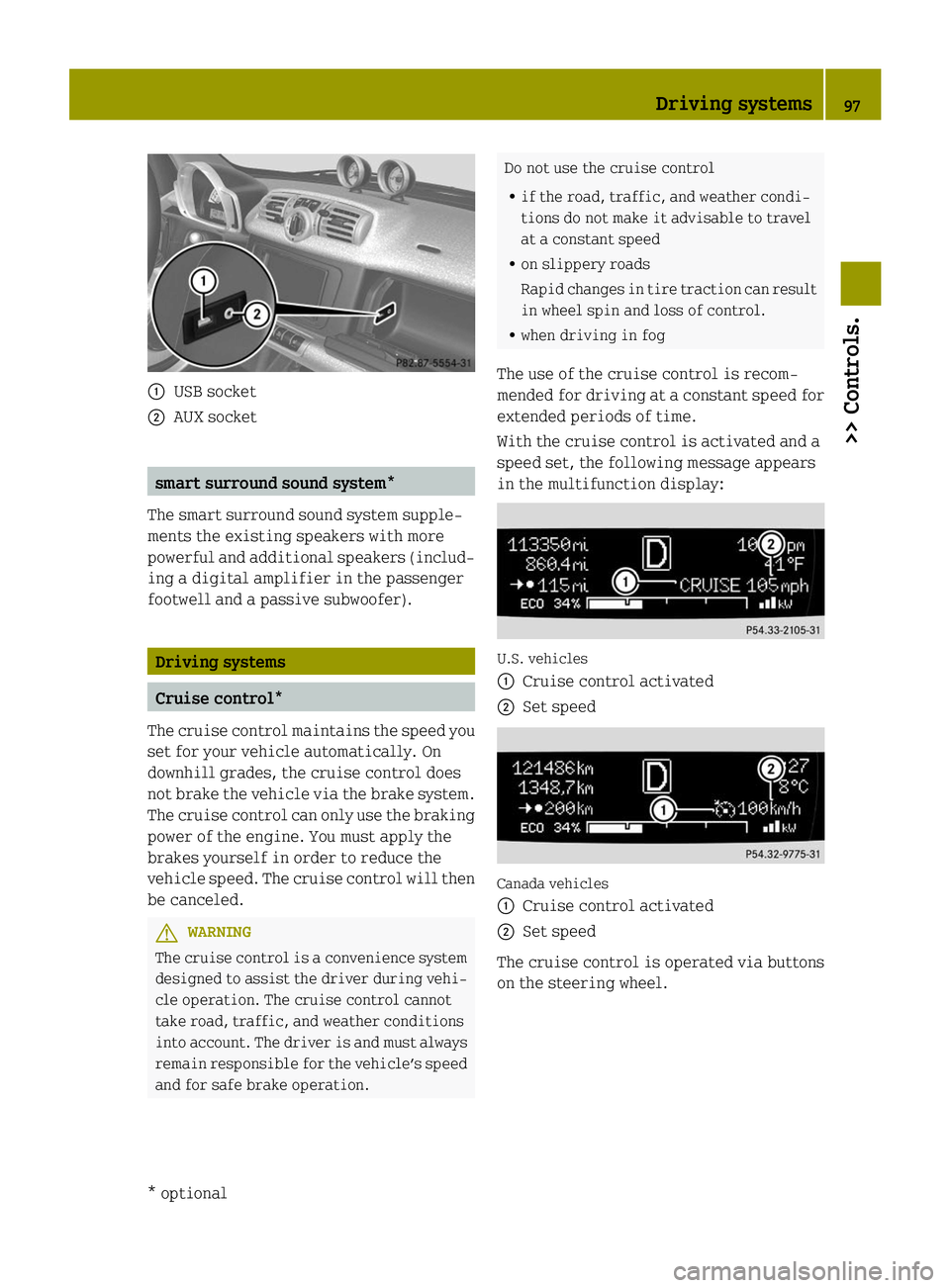
0043
USB socket
0044 AUX socket smart surround sound system*
The smart surround sound system supple-
ments the existing speakers with more
powerful and additional speakers (includ-
ing a digital amplifier in the passenger
footwell and a passive subwoofer). Driving systems
Cruise control*
The cruise control maintains the speed you
set for your vehicle automatically. On
downhill grades, the cruise control does
not brake the vehicle via the brake system.
The cruise control can only use the braking
power of the engine. You must apply the
brakes yourself in order to reduce the
vehicle speed. The cruise control will then
be canceled. G
WARNING
The cruise control is a convenience system
designed to assist the driver during vehi-
cle operation. The cruise control cannot
take road, traffic, and weather conditions
into account. The driver is and must always
remain responsible for the vehicle’s speed
and for safe brake operation. Do not use the cruise control
R
if the road, traffic, and weather condi-
tions do not make it advisable to travel
at a constant speed
R on slippery roads
Rapid changes in tire traction can result
in wheel spin and loss of control.
R when driving in fog
The use of the cruise control is recom-
mended for driving at a constant speed for
extended periods of time.
With the cruise control is activated and a
speed set, the following message appears
in the multifunction display: U.S. vehicles
0043
Cruise control activated
0044 Set speed Canada vehicles
0043
Cruise control activated
0044 Set speed
The cruise control is operated via buttons
on the steering wheel. Driving systems
97>> Controls.
* optional Z
Page 145 of 222
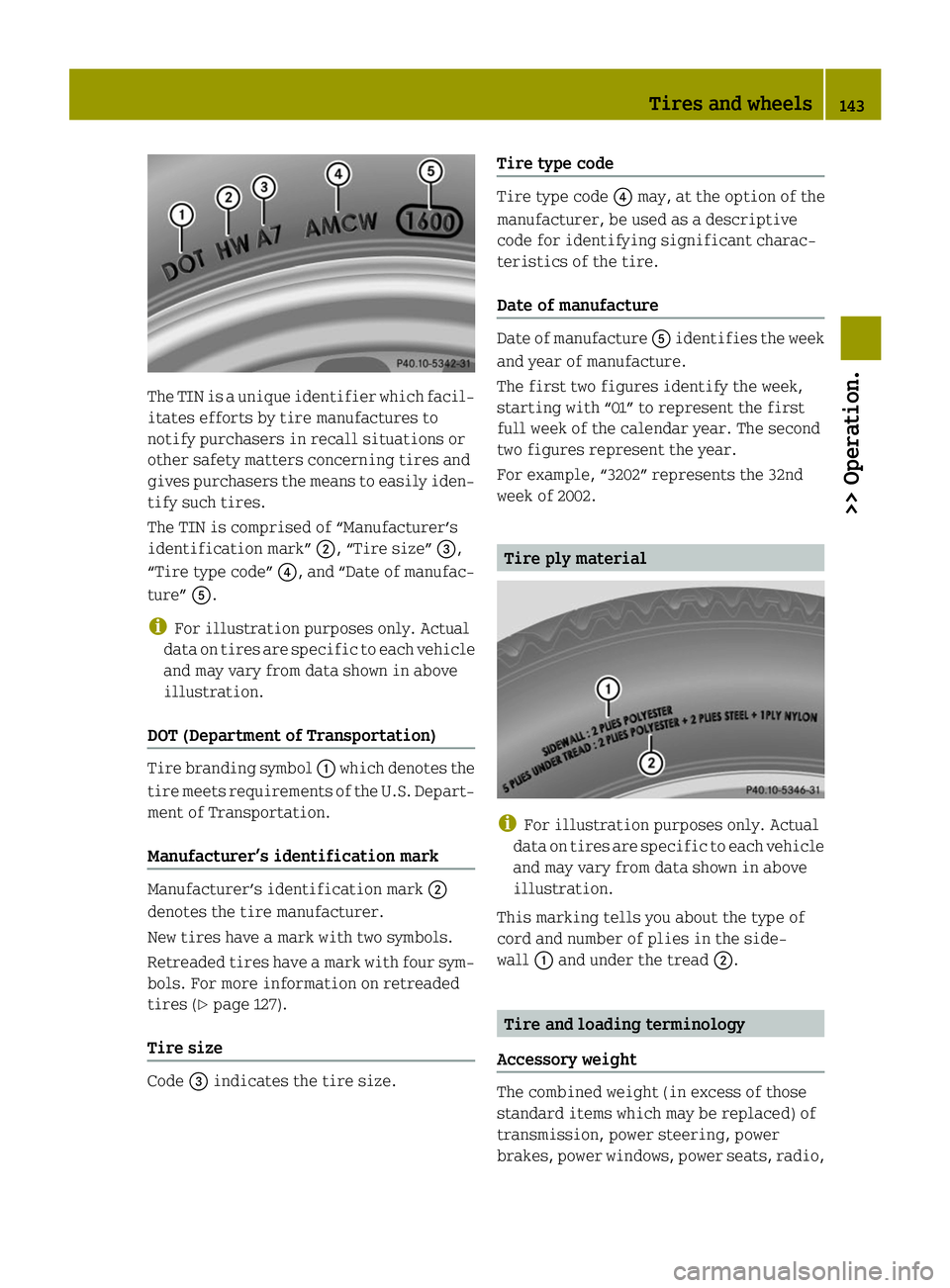
The TIN is a unique identifier which facil-
itates efforts by tire manufactures to
notify purchasers in recall situations or
other safety matters concerning tires and
gives purchasers the means to easily iden-
tify such tires.
The TIN is comprised of “Manufacturer’s
identification mark” 0044, “Tire size”0087,
“Tire type code” 0085, and “Date of manufac-
ture” 0083.
i For illustration purposes only. Actual
data on tires are specific to each vehicle
and may vary from data shown in above
illustration.
DOT (Department of Transportation) Tire branding symbol
0043which denotes the
tire meets requirements of the U.S. Depart-
ment of Transportation.
Manufacturer’s identification mark Manufacturer’s identification mark
0044
denotes the tire manufacturer.
New tires have a mark with two symbols.
Retreaded tires have a mark with four sym-
bols. For more information on retreaded
tires (Y page 127).
Tire size Code
0087indicates the tire size. Tire type code Tire type code
0085may, at the option of the
manufacturer, be used as a descriptive
code for identifying significant charac-
teristics of the tire.
Date of manufacture Date of manufacture
0083identifies the week
and year of manufacture.
The first two figures identify the week,
starting with “01” to represent the first
full week of the calendar year. The second
two figures represent the year.
For example, “3202” represents the 32nd
week of 2002. Tire ply material
i
For illustration purposes only. Actual
data on tires are specific to each vehicle
and may vary from data shown in above
illustration.
This marking tells you about the type of
cord and number of plies in the side-
wall 0043and under the tread 0044. Tire and loading terminology
Accessory weight The combined weight (in excess of those
standard items which may be replaced) of
transmission, power steering, power
brakes, power windows, power seats, radio, Tires and wheels
143>> Operation. Z
Page 149 of 222
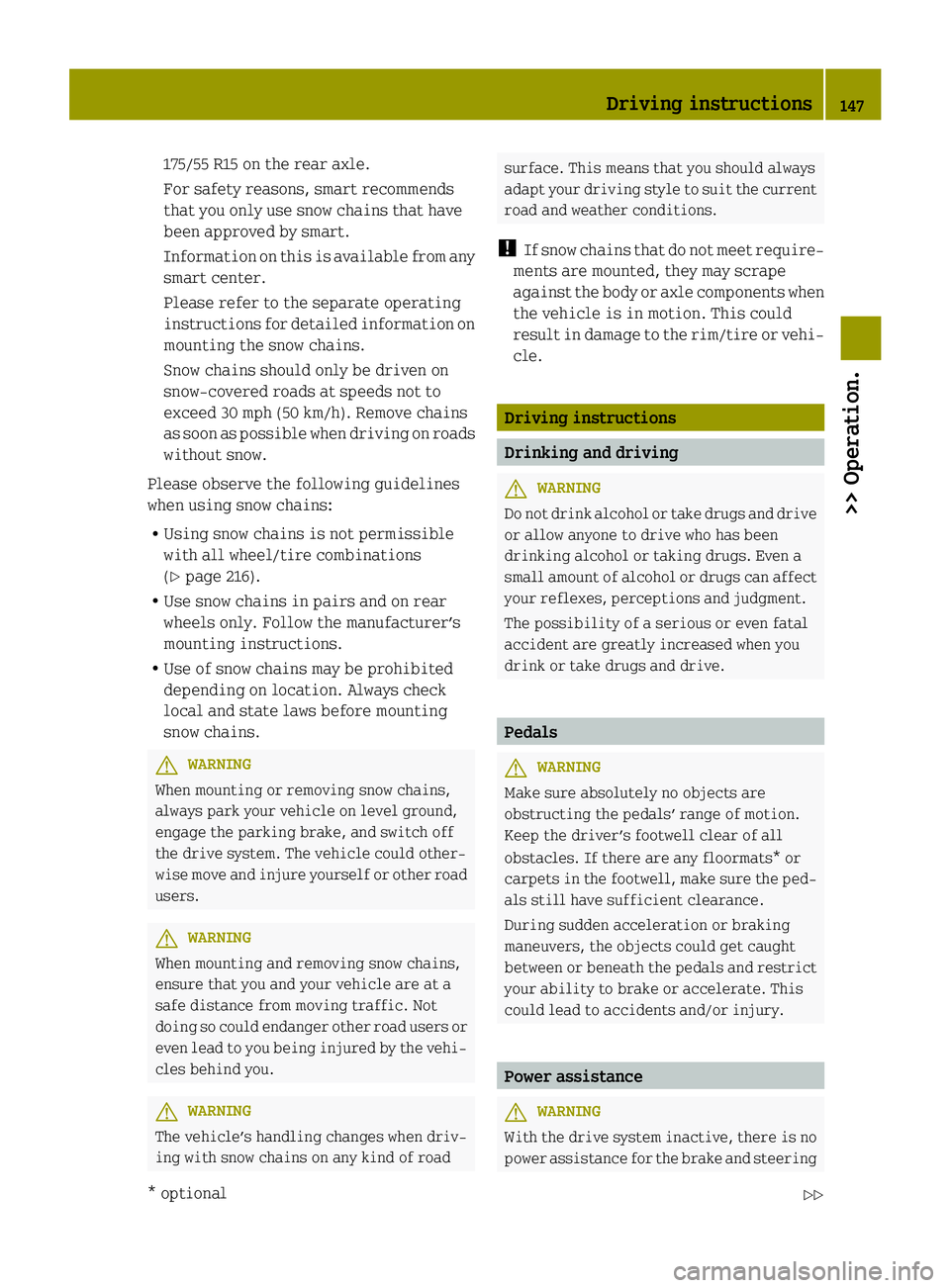
175/55 R15 on the rear axle.
For safety reasons, smart recommends
that you only use snow chains that have
been approved by smart.
Information on this is available from any
smart center.
Please refer to the separate operating
instructions for detailed information on
mounting the snow chains.
Snow chains should only be driven on
snow-covered roads at speeds not to
exceed 30 mph (50 km/h). Remove chains
as soon as possible when driving on roads
without snow.
Please observe the following guidelines
when using snow chains:
R Using snow chains is not permissible
with all wheel/tire combinations
(Y page 216).
R Use snow chains in pairs and on rear
wheels only. Follow the manufacturer’s
mounting instructions.
R Use of snow chains may be prohibited
depending on location. Always check
local and state laws before mounting
snow chains. G
WARNING
When mounting or removing snow chains,
always park your vehicle on level ground,
engage the parking brake, and switch off
the drive system. The vehicle could other-
wise move and injure yourself or other road
users. G
WARNING
When mounting and removing snow chains,
ensure that you and your vehicle are at a
safe distance from moving traffic. Not
doing so could endanger other road users or
even lead to you being injured by the vehi-
cles behind you. G
WARNING
The vehicle’s handling changes when driv-
ing with snow chains on any kind of road surface. This means that you should always
adapt your driving style to suit the current
road and weather conditions.
! If snow chains that do not meet require-
ments are mounted, they may scrape
against the body or axle components when
the vehicle is in motion. This could
result in damage to the rim/tire or vehi-
cle. Driving instructions
Drinking and driving
G
WARNING
Do not drink alcohol or take drugs and drive
or allow anyone to drive who has been
drinking alcohol or taking drugs. Even a
small amount of alcohol or drugs can affect
your reflexes, perceptions and judgment.
The possibility of a serious or even fatal
accident are greatly increased when you
drink or take drugs and drive. Pedals
G
WARNING
Make sure absolutely no objects are
obstructing the pedals’ range of motion.
Keep the driver’s footwell clear of all
obstacles. If there are any floormats* or
carpets in the footwell, make sure the ped-
als still have sufficient clearance.
During sudden acceleration or braking
maneuvers, the objects could get caught
between or beneath the pedals and restrict
your ability to brake or accelerate. This
could lead to accidents and/or injury. Power assistance
G
WARNING
With the drive system inactive, there is no
power assistance for the brake and steering Driving instructions
147>> Operation.
* optional Z
Page 172 of 222
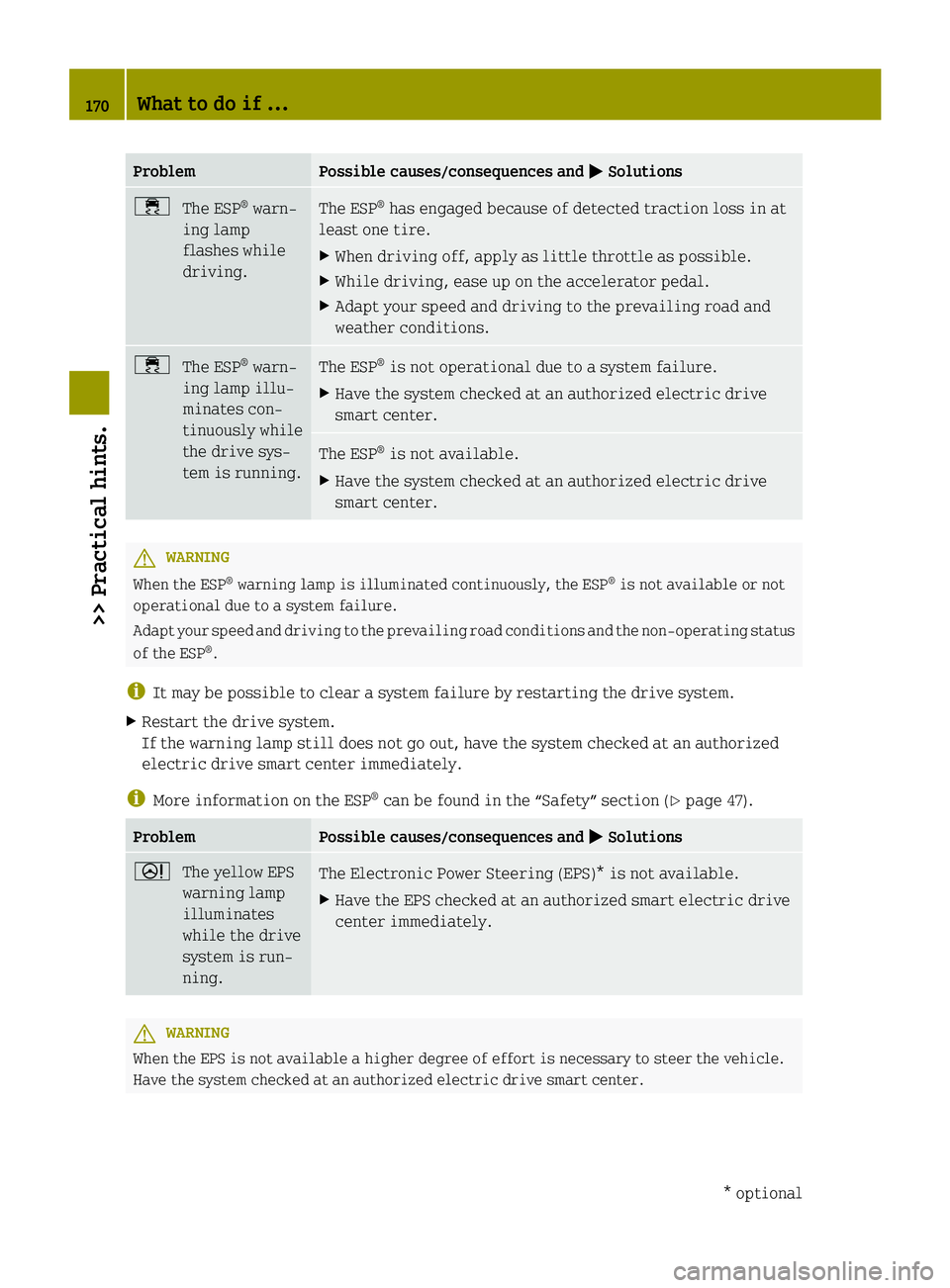
Problem Possible causes/consequences and
0050
0050Solutions 00E5
The ESP ®
warn-
ing lamp
flashes while
driving. The ESP
®
has engaged because of detected traction loss in at
least one tire.
X When driving off, apply as little throttle as possible.
X While driving, ease up on the accelerator pedal.
X Adapt your speed and driving to the prevailing road and
weather conditions. 00E5
The ESP ®
warn-
ing lamp illu-
minates con-
tinuously while
the drive sys-
tem is running. The ESP
®
is not operational due to a system failure.
X Have the system checked at an authorized electric drive
smart center. The ESP
®
is not available.
X Have the system checked at an authorized electric drive
smart center. G
WARNING
When the ESP ®
warning lamp is illuminated continuously, the ESP ®
is not available or not
operational due to a system failure.
Adapt your speed and driving to the prevailing road conditions and the non-operating status
of the ESP ®
.
i It may be possible to clear a system failure by restarting the drive system.
X Restart the drive system.
If the warning lamp still does not go out, have the system checked at an authorized
electric drive smart center immediately.
i More information on the ESP ®
can be found in the “Safety” section (Y page 47).Problem Possible causes/consequences and
0050 0050Solutions 0052
The yellow EPS
warning lamp
illuminates
while the drive
system is run-
ning. The Electronic Power Steering (EPS)* is not available.
X
Have the EPS checked at an authorized smart electric drive
center immediately. G
WARNING
When the EPS is not available a higher degree of effort is necessary to steer the vehicle.
Have the system checked at an authorized electric drive smart center. 170
What to do if ...>> Practical hints.
* optional